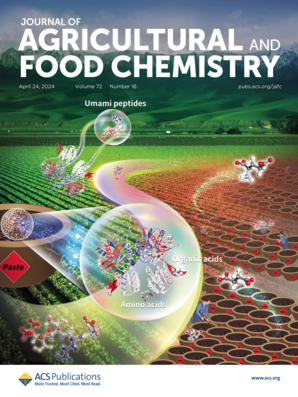Insights into the Pathogenic Role of Fusaric Acid in Fusarium oxysporum Infection of Brassica oleracea through the Comparative Transcriptomic, Chemical, and Genetic Analyses
IF 5.7
1区 农林科学
Q1 AGRICULTURE, MULTIDISCIPLINARY
引用次数: 0
Abstract
Fusarium, a genus of fungi renowned for its plant-pathogenic capabilities, is capable of producing a myriad of structurally diverse secondary metabolites, among which are phytotoxins that play a significant role in the etiology of plant diseases. The particular strain Fusarium oxysporum f. sp. conglutinans (FOC), known as the instigator of Fusarium wilt in cabbage (Brassica oleracea), has been found to secrete an array of toxins and the identities of which have largely remained elusive. In this study, we evaluated the phytotoxicity of crude extracts from the pathogenic FOC strain (FOCr1) and the nonpathogenic F. oxysporum strain (FOcs20) using the cabbage seed phytotoxicity bioassays. Results showed that the crude extract of FOCr1 significantly inhibited seed germination and seedling elongation. Comparative transcriptome analysis and quantitative real-time PCR (qPCR) revealed higher expression levels of a mycotoxin fusaric acid (FA) biosynthetic gene cluster in FOCr1 under host-like conditions (cabbage medium). High-performance liquid chromatography mass spectrometry (HPLC-MS) analysis detected a higher yield FA in the crude extract of FOCr1 but is absent in the FOcs20 strain. Deleting the key gene FUB8 in FOCr1’s FA biosynthetic gene cluster delayed wilt symptoms. Moreover, FA treatment was correlated with an uptick in H2O2 levels within seedlings, underscoring its potential as a virulence amplifier. These results suggest that FA acts as a positive virulence factor in FOC.

求助全文
约1分钟内获得全文
求助全文
来源期刊
CiteScore
9.90
自引率
8.20%
发文量
1375
审稿时长
2.3 months
期刊介绍:
The Journal of Agricultural and Food Chemistry publishes high-quality, cutting edge original research representing complete studies and research advances dealing with the chemistry and biochemistry of agriculture and food. The Journal also encourages papers with chemistry and/or biochemistry as a major component combined with biological/sensory/nutritional/toxicological evaluation related to agriculture and/or food.

 求助内容:
求助内容: 应助结果提醒方式:
应助结果提醒方式:


